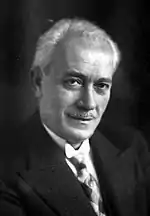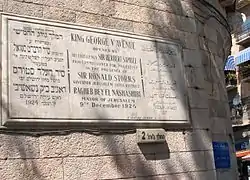Raghib al-Nashashibi | |
|---|---|
 | |
| Mayor of Jerusalem | |
| In office 1920–1934 | |
| Preceded by | Musa al-Husayni |
| Succeeded by | Hussein Khalidi |
| Minister of State and Custodian of the Holy Places of Jerusalem | |
| In office 1 January 1951 – 25 July 1951 | |
| Minister of Transport | |
| In office 4 December 1950 – 1 January 1951 | |
| Minister of Agriculture | |
| In office 12 April 1950 – 11 October 1950 | |
| Minister of State | |
| In office 12 January 1950 – 12 April 1950 | |
| Minister of Refugees | |
| In office 1 September 1949 – 12 January 1950 | |
| Personal details | |
| Born | 1881 Jerusalem |
| Died | 1951 |
| Political party | National Defence Party |
Raghib al-Nashashibi (Arabic: راغب النشاشيبي, Ragheb al-Nashashibī) (1881–1951), CBE (hon),[1] was a wealthy landowner and public figure in Palestine during the Ottoman Empire,[2] the British Mandate and the Jordanian administration. He was a member of the Nashashibi clan, one of the most influential families in Palestine, and mayor of Jerusalem from 1920 to 1934.
Background
Nashashibi graduated from Istanbul University and became Jerusalem's District Engineer. The Nashashibis [3] were one of the oldest and most influential Jerusalem families, and historical rivals of the Husayni family.[4]
Political career

Nashashibi succeeded Musa Kazim al-Husayni as mayor of Jerusalem in 1920,[5] [6] serving in 1927 with Haym Salomon and Jacob Faradj, who were elected as vice-mayors.[7] He was a leading opponent of the Husayni family in Palestine. In 1937 he secretly favoured union with Transjordan.[8] Nashashibi was a founding member of the Arab Higher Committee and a leader of the National Defence Party.
In August 1949 he was appointed head of the new Jordanian ministry for refugees and rehabilitation and was appointed first Governor-General for Arab Palestine in September of that same year. In 1950 he became Jordanian Minister of Agriculture and later Minister of Transport. He was also appointed as custodian of the Holy Places of Jerusalem with cabinet rank.
Personal life
His second wife, a French Jew, lived on Kantura street. Their eldest son was Mansur.[9]
Bibliography
- Sayigh, Yezid (2000). Armed Struggle and the Search for State: The Palestinian National Movement, 1949-1993. Oxford: Oxford University Press. ISBN 0-19-829643-6
See also
- Pro-Jerusalem Society (1918-1926) - Raghib al-Nashashibi, as city mayor, was a member of its leading Council
References
- ↑ A Survey of Palestine - prepared in December 1945 and January 1946 for the information of the Anglo-American Committee of Inquiry. Reprinted 1991 by the Institute of Palestine Studies, Washington. Volume II. ISBN 0-88728-214-8. p.948
- ↑ "Raghib al-Nashashibi - Politicians (1882 - 1951)". Palestinian Journeys. Archived from the original on 2022-01-15. Retrieved 2022-01-13.
- ↑ "Families of Jerusalem and Palestine". Archived from the original on September 22, 2008.
- ↑ Gensicke, Klaus: "Der Mufti von Jerusalem und die Nationalsozialisten. Eine politische Biographie Amin el-Husseinis"; page 19f.; Darmstadt 2007.
- ↑ Tamari, Salim (2008). Mountain against the Sea: Essays on Palestinian Society and Culture. University of California Press. p. 80. ISBN 9780520251298. Retrieved 27 April 2018.
- ↑ Dalin, David (2017). Icon of Evil: Hitler's Mufti and the Rise of Radical Islam. Taylor & Francis. p. 34. ISBN 9781351513968. Retrieved 27 April 2018.
- ↑ "Nashashibi Installed as Jerusalem Mayor" (PDF). No. 750. Jewish Telegraph Agency. JTA. 27 April 1927. p. 1. Archived from the original on 27 April 2018. Retrieved 27 April 2018.
- ↑ Sayigh, 2000, p. 9
- ↑ Jawhariyyeh, Wasif; Nada Elzeer, Translator (2013). "Ragheb Bey and the Oud". In Tamari, Salim; Nassar, Issam (eds.). The Storyteller of Jerusalem: The Life and Times of Wasif Jawhariyyeh, 1904-1948. Olive Branch Press, Interlink Publishing Group. p. 177. ISBN 9781623710392. Retrieved 27 April 2018.
{{cite book}}:|author2=has generic name (help)